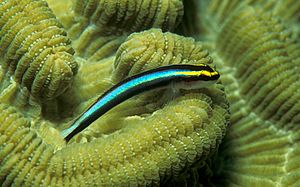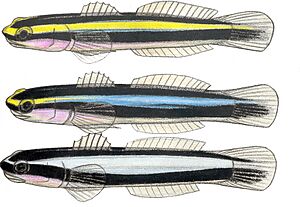Sharknose goby facts for kids
Quick facts for kids Sharknose goby |
|
|---|---|
 |
|
| Elacatinus evelynae resting on a boulder brain coral (Colpophyllia natans) | |
| Conservation status | |
| Scientific classification | |
| Synonyms | |
|
The Elacatinus evelynae, often called the sharknose goby or Caribbean cleaner goby, is a small fish. It lives in the warm waters of the Western Atlantic Ocean. You can find it from the Bahamas and the Lesser Antilles down to the northern coast of South America. It also lives around the Antilles and the western Caribbean.
Contents
What Does It Look Like?
The sharknose goby is a very small fish. It is shaped a bit like a torpedo. It can grow up to about 4 centimeters (1.6 inches) long. It has a bright yellow stripe in front of each eye. These stripes meet to form a "V" shape near its nose.
Black stripes run under the yellow ones. They start from the nose and go past the lower part of the eye. These stripes continue all the way to the end of its tail fin. Like other gobies, its dorsal fin is split into two parts. The front part is rounded, and the back part is flat. All its fins are clear, so you can see through them.
Where Do They Live?
Sharknose gobies live in coral reefs. They prefer clear ocean waters. You can find them at depths from 1 to 53 meters (3 to 174 feet). The water temperature where they live is usually between 22 and 27 °C (72 to 81 °F).
These gobies often stay near or on corals that have large bumps. Examples include great star coral (Montastraea), mustard hill coral (Porites astreoides), and lettuce coral (Agaricia agaricites). They need these bumpy surfaces to hold on. This helps them stay in place when there are strong Ocean currents or waves. They are not strong swimmers, so they need to grip onto things. Staying in one spot helps other fish find them easily for cleaning.
What Do They Eat?
The E. evelynae is known as a cleaner fish. This means it eats tiny ectoparasites and dead skin from other fish. It's like a doctor for other fish! The sharknose goby also eats sponges, sea squirts, coral polyps, and tiny ocean creatures called zooplankton and copepods.
Female gobies tend to clean and eat more than males. This is especially true if a large male is nearby. The male might spend more time guarding the eggs.
Reproduction
Sharknose gobies are monogamous. This means they usually stay with one partner for life. You can often find them in pairs near coral heads. Both males and females will act aggressively towards other gobies of the same sex. This helps them protect their mates.
Scientists have tried to breed them in tanks. They found that these gobies only lay eggs when conditions are just right. The water temperature and salinity (saltiness) must stay very steady.
How Did It Get Its Name?
The specific name evelynae honors Evelyn McCutcheon (1894–1977). She lived in Salt Cay in the Bahamas. She was very kind to James Erwin Böhlke and his friend Charles C. G. Chaplin. Both of them were ichthyologists, which means they studied fish.



